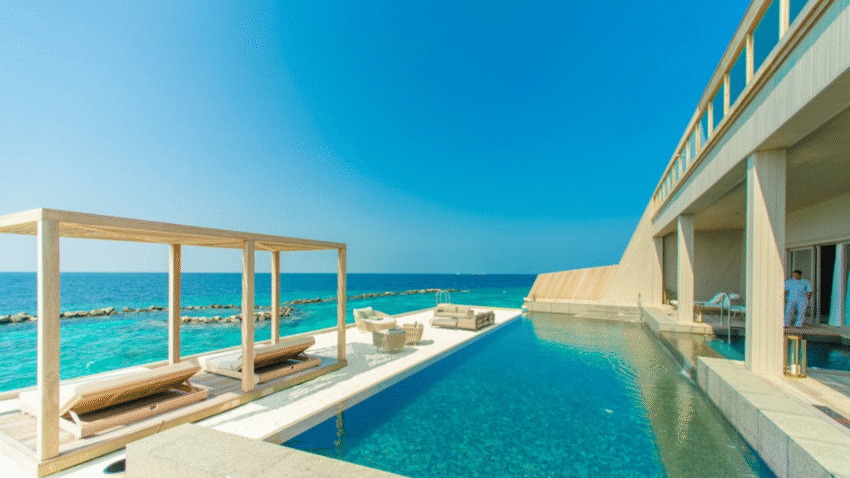Introduction
Tired of looking at slimy green patches clinging to your pool walls? This guide will show you exactly how to remove algae from pool walls and prevent it from coming back. Algae not only ruins your pool’s appearance but also affects water quality and safety. With this step-by-step guide, you’ll learn proven techniques to restore your pool’s sparkle fast and efficiently.
Why Removing Algae from Pool Walls Matters
Algae buildup can create serious issues for your swimming pool. It compromises water clarity, makes surfaces slippery (creating a safety hazard), and disrupts your pool’s pH balance and filtration system. Whether you’re dealing with green, yellow (mustard), or black algae, prompt and thorough removal is crucial to:
- Improve swimmer safety
- Protect the filter and circulation systems
- Restore water clarity and appearance
- Prevent future outbreaks through balanced water chemistry
Step-by-Step Guide to Removing Algae from Pool Walls
Step 1: Test and Balance Your Water
Before any scrubbing begins, test your pool water using a testing kit or strips. Make sure your pH is between 7.2 and 7.6 and that chlorine levels are adequate (1–3 ppm). Adjust these as needed to maximize the effectiveness of your cleaning and shocking treatments.
Pro Tip: Lower pH levels slightly (around 7.2) can make chlorine more effective against algae.
Step 2: Brush the Pool Walls Thoroughly
Use a stiff-bristled pool brush (nylon for vinyl pools, stainless steel for concrete pools) to scrub all algae patches. Focus on areas with visible green, yellow, or black spots. Brushing dislodges algae and allows sanitizers to penetrate the exposed growth.
Caution: Don’t skip this step! Skimming or vacuuming alone won’t remove algae clinging to surfaces.
Step 3: Shock the Pool
After brushing, it’s time to super-chlorinate your pool. Use a chlorine shock product (calcium hypochlorite or sodium dichlor) and follow the instructions on the packaging. In most cases, you’ll need 1 lb per 10,000 gallons—but increase dosage for black or yellow algae.
- Pour the shock around the perimeter of the pool in the evening.
- Run the pool pump for 8–24 hours to circulate the chlorine thoroughly.
Tip: For black algae, use a brush immediately after shocking to help chlorine reach the root-like structures.
Step 4: Run the Filter Continuously
Keep your pump and filter running non-stop for at least 24 hours. This helps remove dead algae from the water and maintains circulation to distribute the chlorine. Check your filter pressure and clean the filter if it’s clogged with debris.
Step 5: Vacuum Up the Dead Algae
After 24 hours, manually vacuum the pool to waste (not back into the filter) if your system allows. This ensures the dead algae is completely removed from the system. For automatic vacuums, monitor for effectiveness and adjust as needed.
Step 6: Backwash or Clean the Filter
If you’re using a sand or DE filter, backwash it after vacuuming. For cartridge filters, rinse thoroughly with a hose or clean with a filter cleaner product. Algae can clog filters quickly, so maintenance here is essential.
Step 7: Rebalance and Retest
After all visible algae is gone, retest your water. Adjust chlorine, pH, and alkalinity to their recommended levels. Also, consider adding a pool algaecide or phosphate remover to help prevent regrowth.
Common Mistakes to Avoid
- Not Brushing Properly
- Many pool owners skip or rush this step. Without breaking algae loose, sanitizers won’t work effectively.
- Solution: Brush thoroughly before shocking, even if it takes extra time.
- Under-Shocking the Pool
- Using too little chlorine means the algae won’t be fully killed.
- Solution: Follow the label dosage carefully and double it for persistent or black algae.
- Turning Off the Pump Too Soon
- Algae may resettle if the pump isn’t run long enough after shocking.
- Solution: Run your filter continuously for at least 24 hours, and check it regularly.
- Ignoring the Filter
- If algae or debris is left in your filter, it can spread back into the pool.
- Solution: Always clean or backwash your filter after shocking and vacuuming.
- Failing to Address the Root Cause
- Algae usually comes back due to poor water balance or circulation.
- Solution: Maintain your chlorine levels, check circulation, and reduce phosphates if needed.
Extra Tips & Pool Hacks
- Use Algaecide Weekly: A weekly dose of a non-copper algaecide can help prevent future outbreaks.
- Shock After Heavy Rain or Pool Parties: These events can deplete chlorine and make your pool vulnerable to algae.
- Brush Hard-to-Reach Areas: Steps, ladders, and corners are algae hotspots. Use specialty brushes if needed.
🧼 Want to keep your pool walls sparkling year-round? Check out our guide on how to clean pool tiles without damaging them for more maintenance tips.
Conclusion
Removing algae from pool walls doesn’t have to be a daunting task. With proper testing, brushing, shocking, and filtering, you can restore your pool to a clean, clear state in just a day or two. Stick to a regular maintenance routine and act quickly at the first signs of algae. Your pool will thank you!
💡 Final Tip: Bookmark this guide so you can refer back the next time algae starts to creep in.
